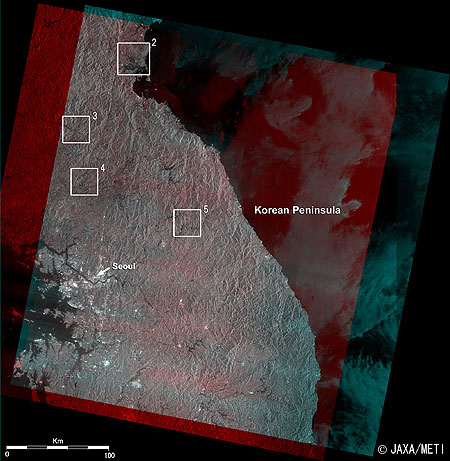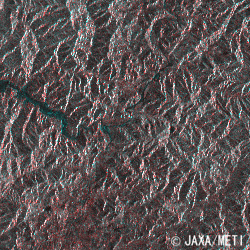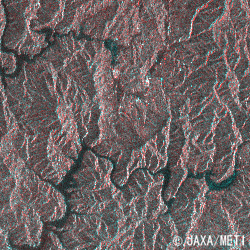Seen from Space 2007
Korean Peninsula Flood by Heavy Rain
JAXA examined the influence of flooding using images acquired before and after the incident. Figure 1 illustrates the influence of flooding with a blue-and-red composition image acquired by JAXA's Earth Observation Satellite "Daichi" on August 11 and July 25, 2007. The large area on the left of the figure is the middle of the Korean Peninsula. Notice the faint red or blue land area. The large red and blue areas on the left and right are not composite and area on the sea.
Figure 2 depicts Kowon and its vicinity on the east coast of the Korean Peninsula (North Korean); it is at the same latitude as Hanamaki City in Iwate Prefecture, Japan. The mouth of river is blue where it has overflown. The mountain near the river on the upper left side looks red, possibly indicating a landslide due to heavy moist soils. Figure 3 depicts the Koksan region in Middle Western Korean Peninsula (Hwanghaepuk-to in North Korea), which is at the same latitude as Tsuruoka City in Yamagata Prefecture, Japan. Fields of 3,7000 hectares are flooded in the granary area of Hwanghaepuk-to; the area is most damaged in North Korea. Figure 4 presents Ichon in the Middle Western Korean Peninsula. The blue dots near the meandering river in the middle of the figure may indicate flooding. Figure 5 shows Yanggu, a strategic point from Seoul to the east coast that is rich in forests and water. You can see the swollen river in the figure. News reports indicated that 11% of the rice and corn fields were lost and foretold serious damage to agricultural crops.
|









